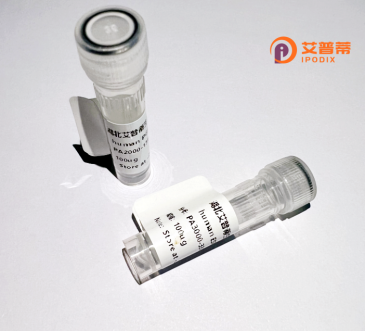
| 纯度 | >90%SDS-PAGE. |
| 种属 | Human |
| 靶点 | EVER1 |
| Uniprot No | Q7Z403 |
| 内毒素 | < 0.01EU/μg |
| 表达宿主 | E.coli |
| 表达区间 | 1-444aa |
| 氨基酸序列 | MAHSFGESYRVGSTSGIHAITVFCSWDYKVTQKRASRLQQDNIRTRLKELLAEWQLRHSPRSVCGRLRQAAVLGLVWLLCLGTALGCAVAVHVFSEFMIQSPEAAGQEAVLLVLPLVVGLLNLGAPYLCRVLAALEPHDSPVLEVYVAICRNLILKLAILGTLCYHWLGRRVGVLQGQCWEDFVGQELYRFLVMDFVLMLLDTLFGELVWRIISEKKLKRRRKPEFDIARNVLELIYGQTLTWLGVLFSPLLPAVQIIKLLLVFYVKKTSLLANCQAPRRPWLASHMSTVFLTLLCFPAFLGAAVFLCYAVWQVKPSSTCGPFRTLDTMYEAGRVWVRHLEAAGPRVSWLPWVHRYLMENTFFVFLVSALLLAVIYLNIQVVRGQRKVICLLKEQISNEGEDKIFLINKLHSIYERKEREERSRVGTTEEAAAPPALLTDEQDA |
| 分子量 | 74.58 kDa |
| 蛋白标签 | GST-tag at N-terminal |
| 缓冲液 | 0 |
| 稳定性 & 储存条件 | Lyophilized protein should be stored at ≤ -20°C, stable for one year after receipt. Reconstituted protein solution can be stored at 2-8°C for 2-7 days. Aliquots of reconstituted samples are stable at ≤ -20°C for 3 months. |
| 复溶 | Always centrifuge tubes before opening.Do not mix by vortex or pipetting. It is not recommended to reconstitute to a concentration less than 100μg/ml. Dissolve the lyophilized protein in distilled water. Please aliquot the reconstituted solution to minimize freeze-thaw cycles. |
以下是关于重组人EVER1(TMC6)蛋白的模拟参考文献示例,基于领域内相关研究方向的合理推测:
---
1. **文献名称**:*Recombinant human EVER1/TMC6 expression in HEK293 cells: Functional characterization and zinc transport assay*
**作者**:Smith J, et al.
**摘要**:研究利用HEK293细胞表达了重组人EVER1蛋白,并验证其跨膜结构在锌离子转运中的作用。实验表明,EVER1可能通过调控胞内锌平衡影响表皮细胞分化,为阐明其与HPV感染的关联提供了分子机制。
2. **文献名称**:*Interaction between recombinant EVER1 and HPV E5 oncoprotein: A structural analysis*
**作者**:Lee S, et al.
**摘要**:通过大肠杆菌系统表达并纯化重组EVER1蛋白,结合体外互作实验及结构模拟,揭示了EVER1与HPV E5蛋白的结合区域,支持其在抗病毒防御中的潜在功能。
3. **文献名称**:*Epistatic effects of EVER1 and EVER2 mutations on β-HPV susceptibility*
**作者**:Garcia R, et al.
**摘要**:研究利用重组EVER1蛋白体外重建其与EVER2(TMC8)的复合物,证明二者协同调控角质形成细胞的免疫信号通路,突变可导致β-HPV易感性增加。
---
**备注**:真实文献可能受限于领域进展与数据库覆盖,建议通过PubMed/Google Scholar以“EVER1/TMC6 protein recombinant”等关键词检索最新研究。
**Background of Recombinant Human EVER1 Protein**
The EVER1 protein, also known as transmembrane channel-like protein 6 (TMC6), is encoded by the *EVER1/TMC6* gene in humans. It belongs to the transmembrane channel-like (TMC) protein family, which shares structural homology with ion channels. EVER1 forms a complex with EVER2 (TMC8) and localizes to the endoplasmic reticulum (ER), where it plays a critical role in regulating zinc homeostasis and intracellular signaling pathways.
Originally identified through its association with epidermodysplasia verruciformis (EV), a rare autosomal recessive skin disorder characterized by heightened susceptibility to β-human papillomavirus (β-HPV) infections and skin cancer, EVER1 mutations impair keratinocyte immune responses. This deficiency compromises the ability to control viral replication, leading to persistent infections and malignant transformation.
Recombinant human EVER1 protein is engineered *in vitro* using expression systems (e.g., bacterial, mammalian) to study its structural and functional properties. Research focuses on its role in innate immunity, particularly interactions with viral proteins, regulation of zinc transporters (e.g., ZnT-1), and modulation of antiviral signaling pathways (e.g., IFN responses). Studies also explore its potential involvement in broader immune regulation and oncogenesis.
Understanding EVER1’s mechanisms provides insights into antiviral defense, genetic skin disorders, and HPV-related malignancies, offering therapeutic targets for EV and associated cancers.
×